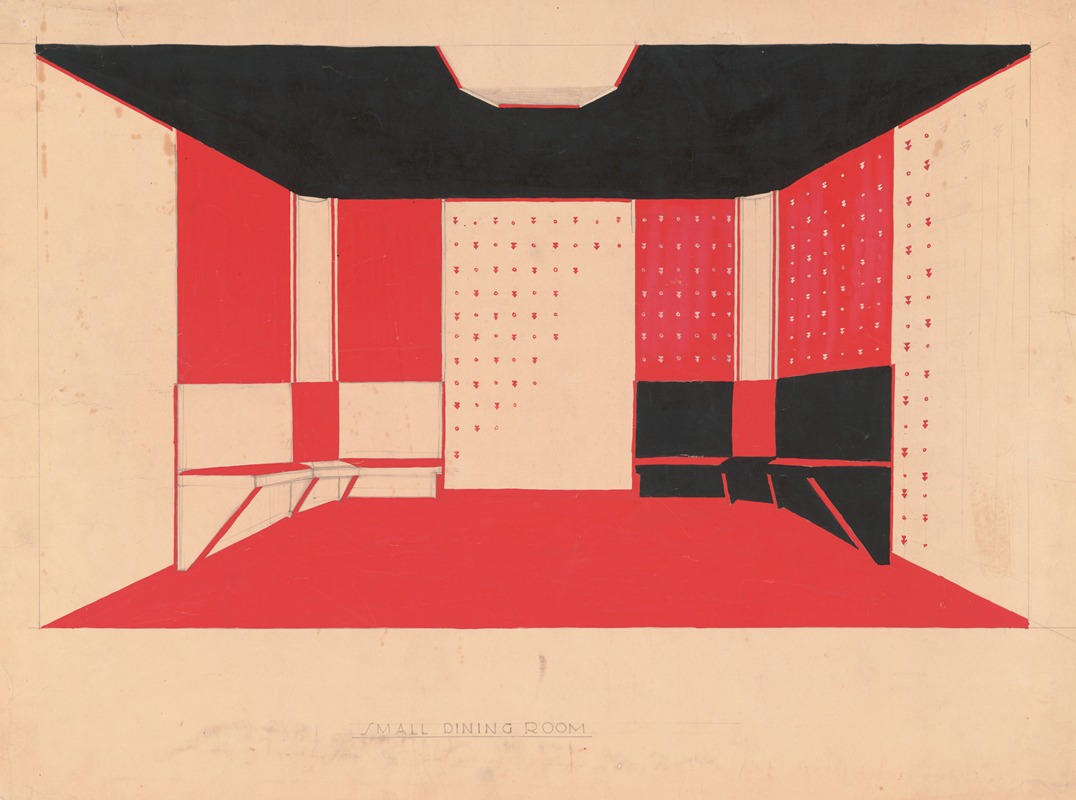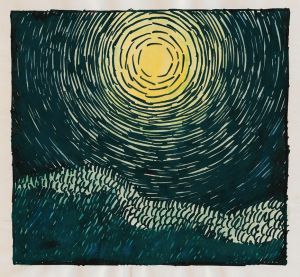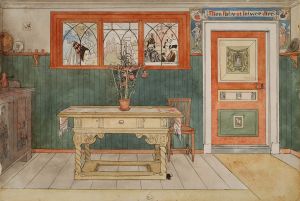
Design for unidentified building ‘Small Dining Room’.] [Drawing of dining room with benches, in black, vermillion and white, bilaterally positive and negative coloring
A hand-painted replica of Winold Reiss’s masterpiece Design for unidentified building ‘Small Dining Room’.] [Drawing of dining room with benches, in black, vermillion and white, bilaterally positive and negative coloring, meticulously crafted by professional artists to capture the true essence of the original. Each piece is created with museum-quality canvas and rare mineral pigments, carefully painted by experienced artists with delicate brushstrokes and rich, layered colors to perfectly recreate the texture of the original artwork. Unlike machine-printed reproductions, this hand-painted version brings the painting to life, infused with the artist’s emotions and skill in every stroke. Whether for personal collection or home decoration, it instantly elevates the artistic atmosphere of any space.
Winold Reiss was a German-American artist and designer known for his contributions to modernist design and his distinctive use of color and form. Born in Karlsruhe, Germany, in 1886, Reiss moved to the United States in 1913, where he became an influential figure in the American art and design scene. His work spanned various mediums, including painting, graphic design, and interior design.
One of Reiss's notable works is the drawing titled "Design for unidentified building ‘Small Dining Room’." This piece features a dining room with benches, rendered in a striking palette of black, vermillion, and white. The design employs bilaterally positive and negative coloring, a technique that creates a dynamic visual contrast and emphasizes the geometric forms within the composition.
Reiss's approach to design was heavily influenced by his European training and the modernist movements of the early 20th century. He studied at the Royal Academy of Fine Arts in Munich, where he was exposed to the principles of Jugendstil (the German counterpart to Art Nouveau) and the emerging trends of modernism. These influences are evident in his use of bold colors, geometric patterns, and a focus on functional yet aesthetically pleasing design.
In the "Small Dining Room" drawing, Reiss's attention to detail and his ability to create a harmonious balance between form and function are apparent. The benches, which are a central element of the design, are depicted with clean lines and a minimalist aesthetic. The use of vermillion, a vivid red pigment, adds a sense of warmth and energy to the space, while the black and white elements provide a stark contrast that enhances the overall visual impact.
Reiss's work often reflected his interest in cultural diversity and his belief in the power of art to bridge different cultural traditions. Throughout his career, he created numerous portraits and designs that celebrated the rich cultural tapestry of America, including his well-known portraits of Native Americans and African Americans. His designs for interiors and public spaces, such as the iconic Harlem nightclub, the Cotton Club, showcased his ability to blend modernist principles with cultural motifs.
The "Small Dining Room" drawing is a testament to Reiss's skill as a designer and his innovative use of color and form. While the specific building for which this design was intended remains unidentified, the drawing itself stands as an example of Reiss's contribution to modernist design and his enduring influence on the field.
Winold Reiss continued to work and teach in the United States until his death in 1953. His legacy lives on through his numerous works and the impact he had on American art and design. His ability to merge European modernist techniques with American cultural themes has left a lasting mark on the art world, making his work a subject of study and admiration for generations to come.









![Design for dčor of restaurant, 56 East 56th St, New York, NY.] [Drawing of suggested dčor for restaurant with color elevation and murals](/imgs/249282/s/winold-reiss-design-for-dcor-of-restaurant-56-east-56th-st-new-york-ny-drawing-of-suggested-dcor-for-restaurant-with-color-elevation-and-murals-29535340.jpg)

![Graphic design drawings for Barricini Candy packages.] [3-D Study, circular candy box with Indian motif on blue background](/imgs/249346/s/winold-reiss-graphic-design-drawings-for-barricini-candy-packages-3d-study-circular-candy-box-with-indian-motif-on-blue-background-8cd7e0d7.jpg)
![Interior perspective studies for Restaurant Crillon, 15 East 48th Street, New York, NY.] [Study for Le Passage or Pullman Room](/imgs/249378/s/winold-reiss-interior-perspective-studies-for-restaurant-crillon-15-east-48th-street-new-york-ny-study-for-le-passage-or-pullman-room-b703bb8b.jpg)
![Proposed treatment for roller rink, Elizabeth, N.J.] [Wall elevations, alpine scheme](/imgs/249388/s/winold-reiss-proposed-treatment-for-roller-rink-elizabeth-nj-wall-elevations-alpine-scheme-cb9ccbaa.jpg)

![Designs for theater with black-framed proscenium and boldly colored settings.] [Study for stage light wall decoration, possibly for Caf ̌Crillon ..](/imgs/249418/s/winold-reiss-designs-for-theater-with-blackframed-proscenium-and-boldly-colored-settings-study-for-stage-light-wall-decoration-possibly-for-caf-crillon--5ac7a006.jpg)

